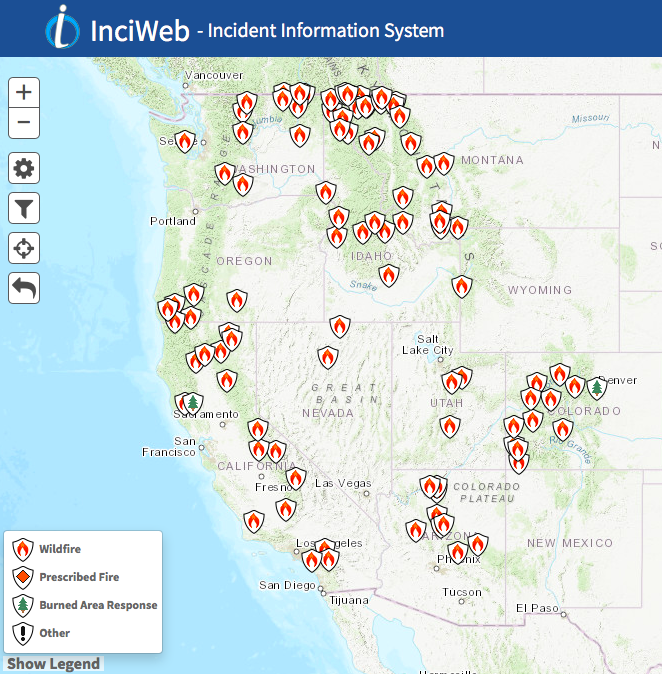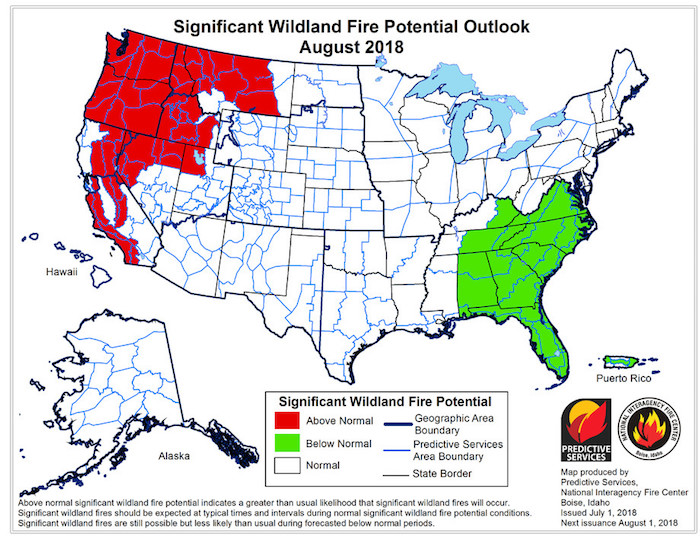This has been a horrific year for wildfires. As I write this, fires are raging throughout the west, threatening resorts, ski towns, backcountry, you name it. Powder recently ran a piece on the subject, but in a nutshell, here’s what’s happening:
According to the National Interagency Fire Center, this year wildfires have burned more than 5.6 million acres, about 27 percent above the average since 2007. Costs to affected communities are in the tens of millions of dollars, and so far, eleven firefighters have lost their lives. The scope of California’s fires is unprecedented. The Carr fire alone, as of August 20, has destroyed 1,079 residences, 22 commercial structures, and 503 outbuildings. The 2018 fire season is slated to be one of the California’s worst, and that’s saying a lot, since 2007 had several record-breaking fires. 820,000 acres have already burned — more than twice the area burned by this point last year.
Take a look at the following map from Inciweb.com:

As of now, no ski area has been directly hit, though the fires have come uncomfortably close. And if current trends continue, I’m afraid it’s only a matter of time.

Fire crews camped at White Pass Ski Area, WA
Fires are a natural part of the ecosystem. They restore nutrients to the soil and clear out decaying brush. But if it seems to you like our fires are getting bigger, badder, and much more frequent, you’re not wrong. In California, for example, 15 of the 20 largest fires in state history have burned since 2000.
What’s behind it?
According to the National Park Service, 90% of wildfires in the US are man made. Someone drops a cigarette, or fails to extinguish a campfire, or burns debris, and boom! You’ve got a raging inferno on your hands.
But climate change is making it worse.
Greenhouse gas emissions, via the greenhouse effect, are causing global temperatures to rise. A warmer climate has drier landscapes, and dry vegetation becomes fuel for fires, making them more likely to spread farther and faster. From 1979 to 2015, climate change accounted for 55 percent of observed increases in land surface dryness in western forests. And since 1980, there has been a fourfold increase in the number of large and long-duration fires in the west. Meanwhile, the length of the fire season there has increased by a whopping 2.5 months on average.

So what can we do?
As skiers, do we just throw up our hands, get rid of our gear, and take up surfing?
NEVER, I shout as I shake my fist at the sky. (No disrespect to surfing, which does look like a lot fun.)
First, we have to make sure we don’t do anything to inadvertently start a fire. Which means completely extinguishing cigarettes before disposal, following local ordinances when burning yard waste, avoiding backyard burning in windy conditions, and keeping a shovel, water, and fire retardant nearby to keep fires in check. Also, don’t light fireworks when conditions are dry or during windy nights. Don’t start campfires during a windy day or in proximity to vegetation. And if you do have a campfire, make sure it’s completely extinguished before moving on.
Second, we have to do what we can to reduce our carbon footprint. How do we do this? By turning off lights. Recycling more and consuming less. Buying things from suppliers that use green manufacturing methods and materials. Thinking twice about driving to the corner for that latte, and walking or biking instead. Combining trips. In short, doing everything we can to minimize the greenhouse gases that are turning up the earth’s thermostat.
But perhaps the most important thing you can do is to let your legislators know that you support efforts to curb greenhouse gases. Because that will have a tremendous impact on what’s happening now and in the future.
A great way to start is by becoming better informed. Here are some websites you might want to check out:
Protect Our Winters is working to unite and actively engage the global snow sports community in the fight against climate change.
Union of Concerned Scientists: offers quality resource sections on global warming and ozone depletion. It includes briefings, updates, FAQs, recommendations, fact sheets, analysis, links, guides, statements and ideas on what you can do.
Climate Solutions offers practical solutions to global warming. Climate Solutions is an Earth Island Institute project. Their mission is to stop global warming at the earliest point possible by helping the Northwestern area of the United States become a world leader in practical and profitable solutions.
Climate Ark is dedicated to promoting public policy that addresses Global Climate Change through reductions in carbon and other emissions, energy conservation, alternative energy sources and ending deforestation.
The World Resources Institute is working to move human society to live in ways that protect Earth’s environment and its capacity to provide for the needs and aspirations of current and future generations.
Want to help those directly affected by the fires?
Then contribute to The American Red Cross , which provides assistance for those who have lost their homes or had to be evacuated. Your financial donation is greatly appreciated.


